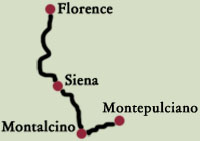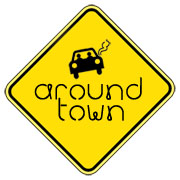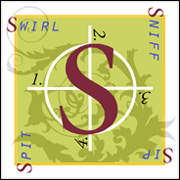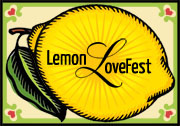|
14 Apr
2008 |
Go Invisible with Vino Nobile 
Towards the end of his famous poem, Bocco in Toscana (Bacchus in Tuscany) published in 1685, Francesco Redi proclaims:
I’m ravished! I’m rapt!
Heav’n finds me admissible.
Lost in extacy! blinded! invisible!
Hearken, all Earth!
We, Bacchus, in the might of our great mirth; —
To all who reverence us, and are right thinkers;
Hear, all ye drinkers!
Give ear, and give faith, to our edict divine! —
Montepulciano’s the King of all Wine.
In Tuscan culture, to “go invisible” means to be carried away in a fit of rapture—to cloud nine, if you will. I guess he really liked the stuff. This, of course, is the same Francesco Redi who, in 1668, conducted his breakthrough experiment to refute the theory of spontaneous generation (remember back in high school—maggots don’t really spring into being from red meat—I guess that ruins any pairing recommendations on this one).
 The Tuscan hill town of Montepulciano is roughly 70-90 miles (110-150 kilometers) southeast of Florence, depending on the route you take. If you pass through Montalcino (the home of Brunello di Montalcino) on the way, the drive is on the longer side, but much more rewarding for obvious reasons. Whatever you do, don’t end your trip at Montalcino, because Montepulciano is only a little further and is the home of Brunello’s lighter cousin, Vino Nobile di Montepulciano (not to be confused with Montepulciano d’Abruzzo, a red wine made from the Montepulciano grape in the southern Italian region of Abruzzo). Vino Nobile di Montepulciano is made 60-80% from Prugnolo Gentile, the local name for Sangiovese Grosso, the grape used 100% for Brunello di Montalcino (notwithstanding the recent Brunello adulteration scandal allegations). Vino Nobile also includes 10-20% Canaiolo Nero grapes and up to 20% other authorized grapes from the Province of Siena, such as Mammolo (which adds smoothness & floral elements). This wine is stored in oak barriques (large barrels) for at least two years (three for riserva). Interestingly, Vino Nobile was the first DOCG designation in Italy.
The Tuscan hill town of Montepulciano is roughly 70-90 miles (110-150 kilometers) southeast of Florence, depending on the route you take. If you pass through Montalcino (the home of Brunello di Montalcino) on the way, the drive is on the longer side, but much more rewarding for obvious reasons. Whatever you do, don’t end your trip at Montalcino, because Montepulciano is only a little further and is the home of Brunello’s lighter cousin, Vino Nobile di Montepulciano (not to be confused with Montepulciano d’Abruzzo, a red wine made from the Montepulciano grape in the southern Italian region of Abruzzo). Vino Nobile di Montepulciano is made 60-80% from Prugnolo Gentile, the local name for Sangiovese Grosso, the grape used 100% for Brunello di Montalcino (notwithstanding the recent Brunello adulteration scandal allegations). Vino Nobile also includes 10-20% Canaiolo Nero grapes and up to 20% other authorized grapes from the Province of Siena, such as Mammolo (which adds smoothness & floral elements). This wine is stored in oak barriques (large barrels) for at least two years (three for riserva). Interestingly, Vino Nobile was the first DOCG designation in Italy.
A good example of Vino Nobile is produced by Nottola, located in the heart of Montepulciano. I’ve tasted their 2003 (which I liked slightly more) and 2004 (which is still available). The 2004 Nottola Vino Nobile di Montepulciano is 80% Prugnolo Gentile, 15% Canaiolo and 5% Mammolo. It is a deep ruby red and pairs well with red meats, poultry (think Chicken Cacciatora, for example) and many cheeses. I like this wine because it is enjoyable all by itself or with appetizers or an entire meal. I’ve found it at Costco in Los Angeles for under $16 and have seen it occasionally on the internet for a bit more. This isn’t the only Vino Nobile around, though it has more body than some I’ve tasted. Like Redi, be a scientist and a poet—do some vino experimenting! Pick up a Vino Nobile and see for yourself whether Redi was a right thinker.
As a Brunello lover, I appreciate Vino Nobile di Montepulciano even though it is quite a bit lighter. In fact, if you find Brunellos too heavy, then you might prefer a Vino Nobile. In addition to its Vino Nobile and Vino Nobile Riserva, Nottola has a Vino Nobile di Montepulciano Vigna del Fattore that is 100% Prugnolo Gentile grape from a single vineyard. I haven’t had a chance to try it yet, but I’m hoping to do so soon to see if it is a real kissin’ cousin to Brunello.
Many writers say that Redi’s poem ends with his oft-quoted affirmation of Montepulciano as the King of all Wine. That, in fact, is not the final strain. The poem actually ends with what is either a warning or a further endorsement of the wine, depending on your perspective:
At these glad sounds,
The Nymphs, in giddy rounds,
Shaking their ivy diadems and grapes,
Echoed the triumph in a thousand shapes.
The Satyrs would have joined them; but alas!
They couldn’t; for they lay about the grass,
As drunk as apes.
The Giomarelli family purchased the Nottola’s historic estate (formerly the 19th century Villa Bracci) and about 10 hectares (nearly 25 acres) of surrounding vineyards in the late 1980s from the Antinori family. Their plan was to renovate the property for resale, but they fell in love with the land and have since acquired more of the adjacent vineyards for a total of about 23 hectares (nearly 57 acres). We can all be glad they did, because they are now consistently producing high–quality wines.















